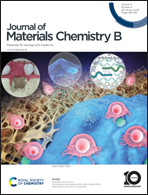Starch-based shape memory sponge for rapid hemostasis in penetrating wounds†
Abstract
Death caused by excessive blood loss has always been a global concern. Timely control of bleeding in incompressible penetrated wounds remains a great challenge. Here, we developed a shape memory sponge (SQG) based on modified starch and gelatin (Gel) to control the hemorrhage of penetrating wounds. The porous structure of SQG greatly enhanced the absorption of blood, and the adhesion of erythrocytes and platelets. The water absorption rate of SQG reached 1178.72 ± 12.18% in 10 s. SQG quickly recovered its shape in water (∼3 s) and exhibited high mechanical strength (∼38 kPa), acting as a physically packed barrier to facilitate hemostasis. Furthermore, the positively charged sponges were conducive to activating platelets and promoting the release of coagulation factors. SQG sponges possessed the lowest blood coagulation index (BCI) of 21.32 ± 0.19%, and presented good biocompatibility and obvious inhibitory effect on Escherichia coli (E. coli) and Staphylococcus aureus (S. aureus). Moreover, SQG sponges controlled complete bleeding in 69 ± 20 s and a bleeding loss of 334 ± 138 mg was observed, nearly 50% lower than that of gelatin sponge in rabbit liver penetrating wounds. Overall, SQG possesses a combination of potent shape recovery, rapid hemostasis, and excellent antibacterial and degradation ability, enabling promising applications for hemostasis in non-compressible penetrating wounds.



 Please wait while we load your content...
Please wait while we load your content...